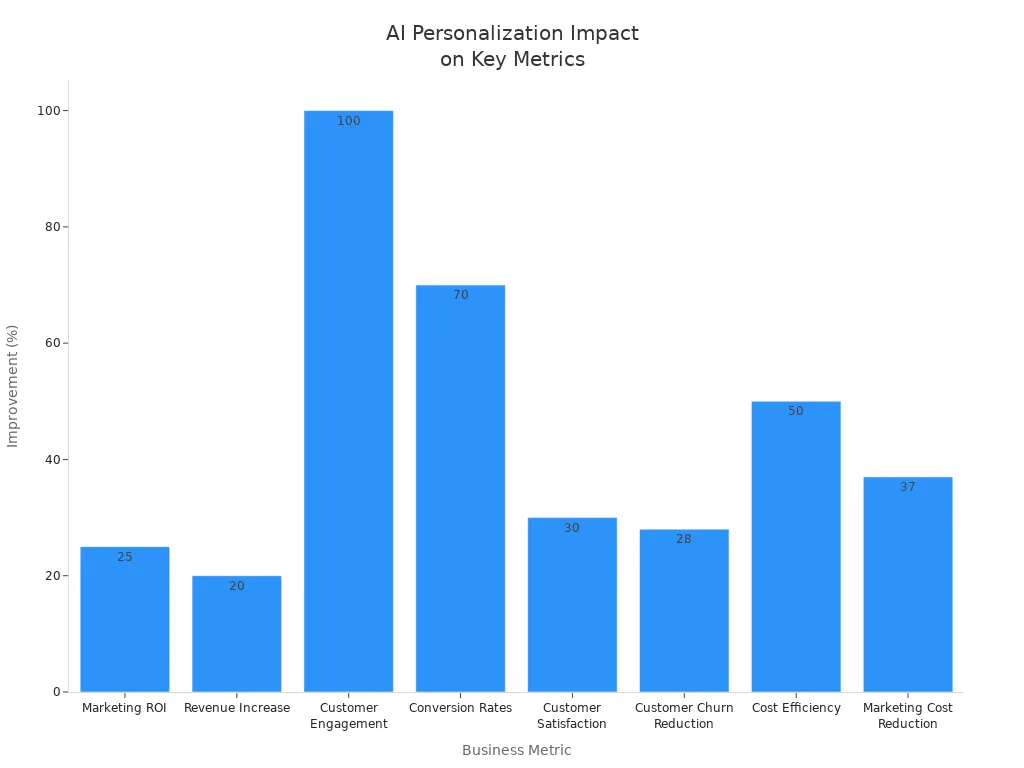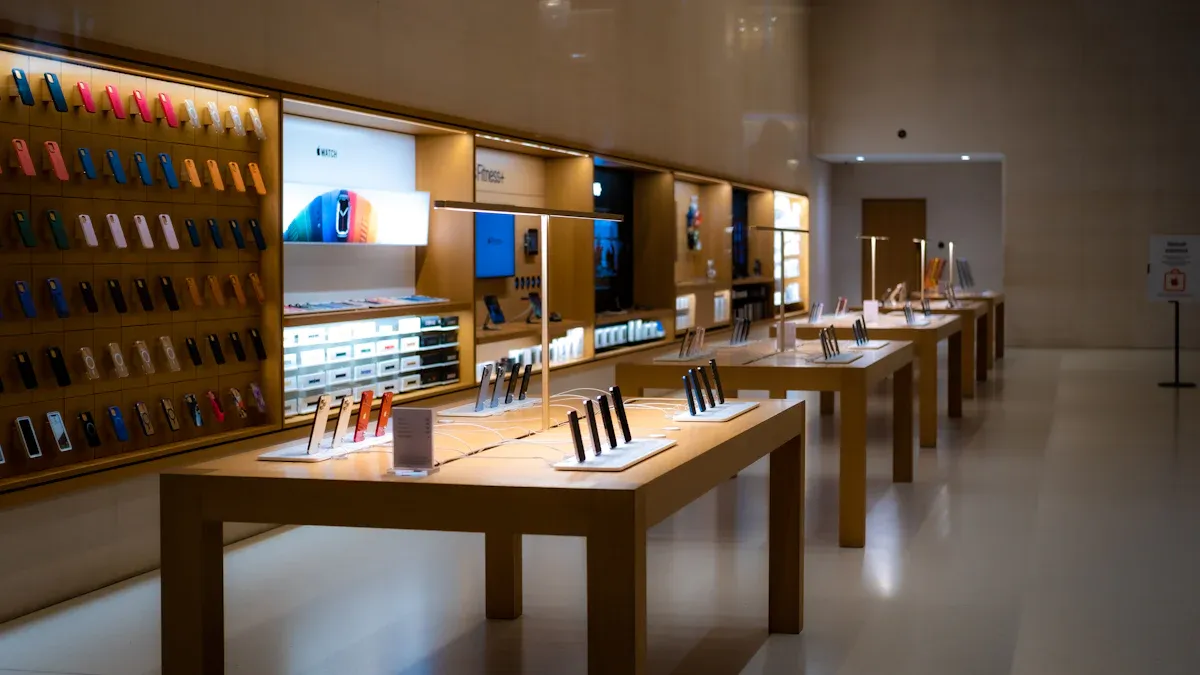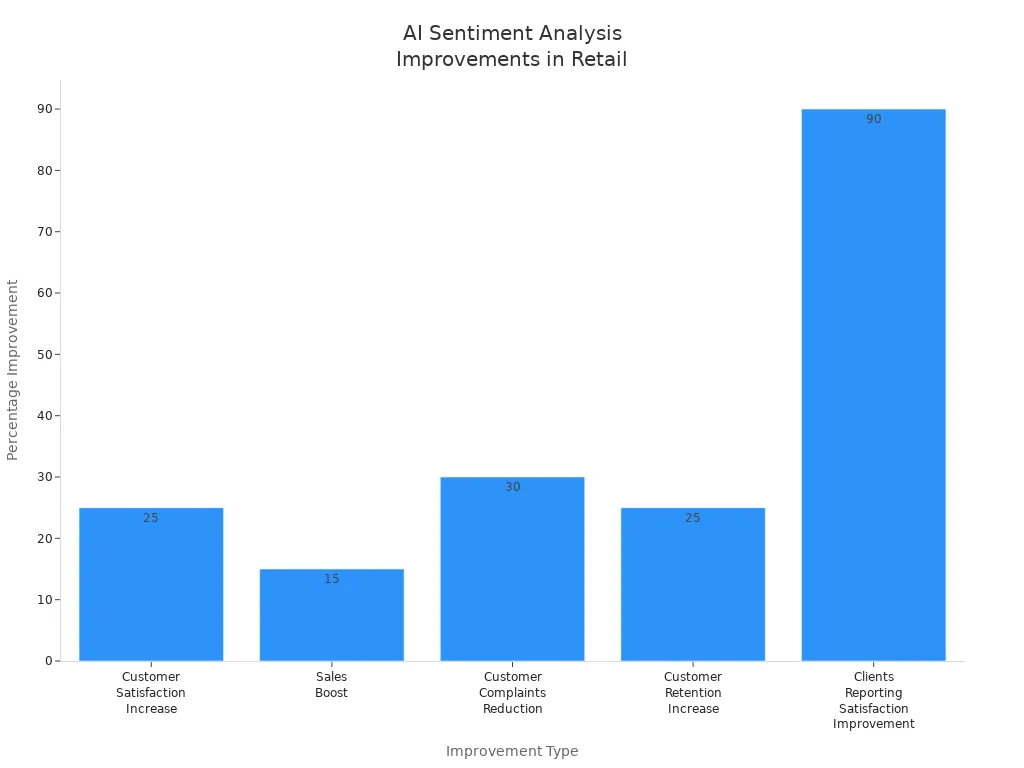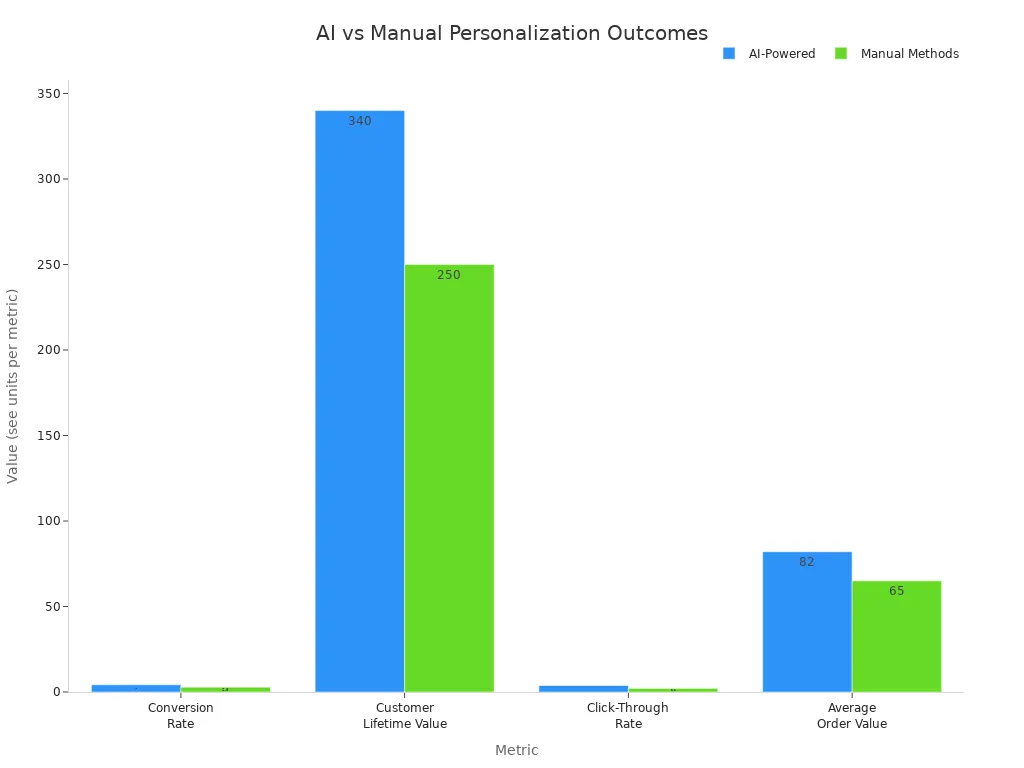AI Retail Store Personalization: How to Make Shoppers Stay Longer

You want shoppers to stay longer in your store. AI Retail Store personalization helps you do just that. Did you know 75% of people are more likely to return when they get a personalized experience? Even better, personalization can boost customer satisfaction by 15% and double engagement rates. Take a look at how loyalty and retention drive success:
Evidence Type | Description |
|---|---|
Emotional Engagement | 70% of emotionally engaged shoppers spend twice as much as less engaged ones |
Customer Lifetime Value | Loyalty programs encourage repeat visits and deeper brand connections |
Brand Advocacy | Happy customers become brand advocates, fueling growth and profit |

Personalized service means more sales, happier customers, and stronger loyalty.
Key Takeaways
AI personalization can increase customer retention by making shoppers feel valued and understood.
Using AI-driven recommendations can boost sales by up to 89%, helping stores suggest products that match your preferences.
Real-time feedback systems allow stores to adapt quickly, improving customer satisfaction and addressing issues as they arise.
Gamified loyalty programs engage customers by offering personalized rewards, making shopping more fun and encouraging repeat visits.
Tracking dwell time and sales growth helps stores measure the effectiveness of AI strategies, leading to better shopping experiences.
AI Retail Store Personalization

Shopper Behavior
You probably notice how some stores just seem to know what you want. That’s not magic—it’s the power of an AI Retail Store at work. These stores use smart technology to watch how you shop, what you pick up, and even how long you stand in one spot. This helps them figure out what you like and what you might want next.
Here’s how AI Retail Store technology learns about your shopping habits:
Natural Language Processing (NLP) lets stores understand what you say or type, so they can help you faster.
Generative AI looks at tons of data in real time. It creates personalized suggestions and content just for you.
Predictive analytics guesses what you might want to buy next, so you see things you actually care about.
AI Retail Store systems also track things like where you walk, how long you stay in certain areas, and what you put in your basket. They even combine your online and in-store shopping data to make better recommendations. For example, if you shop more in the evening or prefer certain products when it rains, the store can adjust what it shows you.
Did you know? AI Retail Store personalization can boost purchases by up to 89% when it focuses on your behavior and preferences.
Here’s a quick look at how stores use this information:
Aspect | Description |
|---|---|
Behavioral tracking | Analyzes foot traffic patterns, dwell times, and basket analysis to optimize store layouts. |
Unified profiles | Combines online and in-store data to predict customer needs and enhance recommendations. |
Predictive analytics | Uses data to forecast demand and manage inventory effectively, improving customer satisfaction. |
Retention Benefits
When you feel like a store “gets” you, you want to come back. That’s why AI Retail Store personalization is so powerful. It helps stores keep you happy and coming back for more.
Let’s look at some real results:
Stitch Fix saw a 40% jump in repeat purchases after using AI personalization.
The same company boosted customer retention by 15%. That means more people kept shopping there instead of leaving for another store.
Personalized experiences make you feel special. You build a stronger connection with the brand, and you’re more likely to return. Here’s what happens when stores use AI Retail Store personalization:
Customer retention rates go up.
You feel more connected to the brand and want to shop there again.
Check out this table to see how AI Retail Store personalization impacts loyalty and sales:
Evidence Description | Impact on Conversion Rates and Customer Loyalty |
|---|---|
AI-driven personalization influences customer loyalty | Strengthens emotional attachment and encourages repeat purchases |
Dynamic personalization improves customer experience | Increases likelihood of repeat purchases and long-term loyalty |
Dynamic content personalization generates an 89% increase in purchases | Significant boost in conversion rates through behavior-focused personalization |
Machine learning delivers 20-30% higher campaign ROI | Higher effectiveness in marketing campaigns leading to increased sales |
You can see that AI Retail Store personalization doesn’t just make shopping easier. It helps stores grow by keeping you happy, loyal, and ready to shop again.
Personalized Experience

Product Recommendations
Have you ever walked into a store and felt like the products on display were picked just for you? That’s the magic of an AI Retail Store. These stores use smart systems to figure out what you like and suggest items that match your style. You get to see things you actually want, not just random products.
AI uses different methods to make these suggestions. Here’s a quick look at how it works:
Description | |
|---|---|
Collaborative Filtering | Suggests items based on preferences of similar users. |
Content-Based Filtering | Recommends items based on attributes of previously liked items. |
Hybrid Systems | Combines collaborative and content-based methods for improved accuracy. |
Deep Learning | Uses neural networks to uncover complex patterns for personalized recommendations. |
Knowledge-Based Systems | Recommends items based on explicit user inputs and domain-specific rules. |
Stores like Netflix and Amazon use these systems to show you movies or products you’ll probably enjoy. You get a shopping experience that feels personal and fun.
Promotions
You know that feeling when you get a special offer that seems made just for you? AI Retail Store technology makes that happen. It watches how you shop and sends you deals that fit your interests. You might see a discount on your favorite snacks or a coupon for something you’ve looked at before.
AI-powered promotions do more than just offer savings. They help you find new products and encourage you to buy more. Here’s what happens:
Real-time personalization adapts to your shopping habits instantly.
Brand-aligned interactions keep the store’s voice and values clear.
Scalable customer guidance means you get help without waiting for staff.
Data-driven insights improve your experience every time you shop.
Stores see big results from these smart promotions. Conversion rates can jump by 15-30%. Fewer people leave their carts behind, and average order values go up. You feel happier and more satisfied because you get deals that matter to you.
Tip: Next time you get a personalized offer, remember that AI is working behind the scenes to make your shopping trip better.
AI Assistance
Chatbots
Have you ever needed help in a store and wished someone could answer your question right away? AI chatbots make that possible. You can ask a chatbot anything, and it gives you answers instantly. You don’t have to wait for a staff member to become available. Chatbots work all day and night, so you get help even after the store closes.
Here’s what makes chatbots so helpful in an AI Retail Store:
You get real-time responses to your questions, no matter how busy the store is.
Chatbots never take breaks, so you always have support.
They can talk to many shoppers at once, which means you don’t have to wait in line.
Chatbots handle simple questions, so staff can help with bigger problems.
Tip: Next time you see a chatbot pop up on a store’s website or kiosk, try asking it a question. You’ll get help fast!
Smart Kiosks
Smart kiosks are changing the way you shop. When you walk into a store, you might see a kiosk that helps you find products, check prices, or even suggest recipes. These kiosks use AI to make your shopping trip easier and more fun.
AI-powered kiosks take care of routine tasks, so staff can focus on helping you with special requests. You get a personalized experience, and employees have more time to solve problems or build relationships with shoppers.
Here’s how smart kiosks make your visit better:
They automate simple tasks, like self-checkout or finding items.
You get suggestions based on your preferences, which makes shopping more enjoyable.
Staff can spend more time helping you with unique needs.
Let’s look at some examples:
Store Type | How Smart Kiosks Help You |
|---|---|
Grocery Stores | |
Fashion and Apparel | Virtual try-ons, style advice |
Quick-Service Restaurants | Custom menu recommendations |
With chatbots and smart kiosks working together, you get faster service and a smoother shopping experience. Staff can focus on what matters most—helping you and making your visit memorable.
Engagement
Interactive Displays
When you walk into a modern store, you might see big screens that react when you touch them. These are interactive displays powered by AI. They help you find products, learn about new items, or even get style tips. You can swipe, tap, or scan a product, and the display shows you more options that match your taste. This makes shopping feel fun and personal.
AI-powered displays do more than just look cool. They use smart technology to learn what you like. For example, if you often check out sneakers, the display will show you the latest styles or deals on shoes. You get suggestions that fit your interests, so you spend more time exploring.
Here are some top AI engagement tools you might see in stores:
Tool Name | Key Features | Best For |
|---|---|---|
Shows products often bought together, finds similar items, and personalizes suggestions | Stores wanting to boost product discovery and personalization | |
Persona by Delve AI | Creates customer personas and updates them with new data | Businesses aiming for better customer targeting |
Mouseflow | Tracks how shoppers use displays and finds ways to make the experience smoother | Teams looking to improve customer journeys |
Gamification
Shopping can feel like a game when stores use AI-powered gamification. You might earn points for trying new products, unlock rewards for visiting often, or take part in fun challenges. These features keep you interested and make you want to come back.
Gamification does more than entertain. It helps you feel special and gives you reasons to return. Stores learn what you enjoy and offer rewards that match your habits. This builds loyalty and makes shopping more exciting.
Tip: Next time you see a store game or challenge, give it a try. You might win a prize or discover something new!
AI-driven engagement tools bring many benefits:
You get a better experience with tailored rewards and challenges.
Stores learn from your actions and improve their services.
Engaged shoppers often spend more and visit again.
Benefit | Description |
|---|---|
Higher Spending | Engaged customers try more products |
Better Experience | Tailored rewards and challenges create excitement |
Customer Insights | Data helps stores refine their offerings |
With interactive displays and gamification, shopping becomes more than just buying things—it becomes an adventure you want to repeat.
Sentiment Analysis
AI can read the mood in your store. It listens to what shoppers say, watches their reactions, and even checks reviews or social posts. You get a real-time look at how people feel. This helps you make your store a place where everyone wants to shop.
Real-Time Feedback
Imagine you walk into a store, and the staff already knows what makes you happy. AI makes this possible by collecting feedback as you shop. You might leave a quick rating on a kiosk or answer a short survey on your phone. AI reads these signals right away.
Here’s how real-time feedback helps you and the store:
You get better service because staff can fix problems fast.
Stores spot trends and know what shoppers want.
Instant feedback agents collect your opinions while you shop.
Retailers use your feedback to make shopping smoother and more fun.
Stores can quickly close service gaps and improve your experience.
Tip: If you see a feedback screen in a store, try it out. Your opinion can shape your next visit!
Store Adaptation
AI does more than just listen. It helps stores change and improve based on what you and other shoppers feel. When AI spots a problem—like long lines or missing products—it can alert staff right away. Stores can then adjust displays, restock shelves, or even change music to match the mood.
Check out how AI sentiment analysis helps stores run better:
Aspect | Description |
|---|---|
AI learns what you like and how you feel. | |
Personalization | Stores use your mood to make shopping more personal. |
Inventory Management | AI predicts what you’ll want next, so shelves stay stocked. |
Operational Efficiency | Staff get data to make smart decisions fast. |
Real-World Examples | Big names like Amazon and Walmart use AI to set prices and manage stock. |
Predictive Analytics | AI guesses future trends to keep you happy. |
Supply Chain Optimization | Stores avoid running out or overstocking by using AI insights. |
You might wonder if this really works. The numbers say yes! Stores using AI sentiment analysis see big improvements:
Improvement Type | Percentage Improvement |
|---|---|
Customer Satisfaction Increase | 25% |
Sales Boost | 15% |
Customer Complaints Reduction | 30% |
Customer Retention Increase | 25% |
Clients Reporting Satisfaction Improvement | 90% |

With AI, you get a store that listens, learns, and adapts—making every visit better than the last.
Loyalty Optimization
Rewards Programs
You want rewards that feel special. AI makes loyalty programs smarter by learning what you like and giving you offers that match your interests. Instead of getting the same coupon as everyone else, you receive deals that fit your shopping habits. When you browse, AI watches what you do and sends you rewards in real time. You might see a discount pop up for your favorite snack or get bonus points for trying something new.
Did you know? Gamified loyalty programs now get more people to join and play along than old-fashioned ones. You earn points, unlock badges, and complete fun challenges—all designed just for you.
Here’s how AI-driven loyalty programs work:
Feature | Description |
|---|---|
Personalization | You get offers that match your style, not just random deals. |
Real-time engagement | Rewards show up while you shop, keeping you interested. |
Gamification | You play games and finish challenges for extra perks. |
Advanced analytics | Stores study your actions to make rewards even better. |
Gamified programs boost engagement and make shopping fun.
Real-time offers encourage you to act fast and grab deals.
Personalized challenges keep you coming back for more.
Predictive Analytics
AI doesn’t just guess what you want—it predicts it. With smart algorithms, stores know what you might buy next and suggest products that fit your taste. This makes your shopping trip smoother and more exciting. By looking at your past purchases and browsing habits, AI helps stores give you better recommendations.
AI-powered predictions will run 95% of customer interactions by 2025.
Predictive analytics can raise your average order value by 40% and conversion rates by 30%.
Personalized recommendations lead to a 25% jump in sales and a 15% boost in satisfaction.
When stores use advanced personalization, you get unique experiences. This can mean a 10-12% increase in revenue for retailers. You feel valued, and stores grow stronger.
With AI loyalty optimization, you get rewards that matter and shopping that feels personal. Stores see more sales, and you enjoy every visit.
Measuring Impact
Dwell Time Metrics
You want to know if shoppers stay longer in your store. Dwell time metrics help you see how much time people spend browsing, trying products, or exploring displays. When you use AI personalization, you can track these numbers and spot patterns. You might notice shoppers spend more time in areas with personalized displays or offers. Longer dwell times often mean people feel more engaged and interested.
You can use smart cameras, sensors, and mobile apps to measure dwell time. These tools show you which parts of your store attract the most attention. You can also see if shoppers return to certain spots or interact with displays more than once. If you see dwell time going up, your AI strategies are working.
Tip: Try setting up alerts for areas with low dwell time. You can adjust displays or offers to make those spots more inviting.
Sales Growth
Tracking sales growth helps you see the real impact of AI personalization. You want to know if shoppers buy more, return often, and feel happier. Key performance indicators (KPIs) give you a clear picture. Here’s a table showing important KPIs and what they mean:
KPI | Description | Evidence Source |
|---|---|---|
Engagement rates | Measures interaction with personalized content (e.g., email open rates). | Personalized emails have an average open rate of 22.1%, compared to 14.5% for non-personalized emails. |
Conversion lift | Measures increase in conversions from personalized experiences. | Personalized marketing can lead to a 10-15% increase in conversion rates. |
Repeat purchase frequency | Tracks customer return rates indicating loyalty. | 55% of Amazon customers are more likely to return due to personalized experiences. |
Customer satisfaction scores | Measures satisfaction with personalized experiences. | Companies using personalization see a 15% increase in customer satisfaction rates. |
Average order value (AOV) | Indicates effectiveness of personalized recommendations. | N/A |
Customer churn rate | Measures the rate at which customers stop purchasing. | N/A |
Return on investment (ROI) | Evaluates financial effectiveness of personalization strategies. | N/A |
You can use these KPIs to guide your strategy. Here are some tools and tips to help you measure and improve results:
Define KPIs that match your goals.
Track ROI to see if your investment pays off.
Test and update your AI models often.
Use data to improve customer engagement and reduce churn.
Build stronger relationships and maximize marketing results.
When you measure impact, you see what works and what needs fixing. You get better results and happier shoppers.
You see how AI personalization changes retail. Stores like BrandAlley and Walmart boost loyalty and sales with smart recommendations. Take a look at these results:
Retailer | Impact on Shopper Retention |
|---|---|
Zalando | Improved satisfaction and loyalty |
Walmart | Increased sales with AI discounts |
BrandAlley |

AI helps you stay longer, shop more, and feel valued. Will you embrace the future of retail and let AI make your shopping experience even better?
FAQ
How does AI know what I like in a store?
AI watches what you browse, buy, and even how long you look at things. It learns your habits and suggests products you might enjoy. You get a shopping experience that feels made just for you.
Will AI personalization make shopping faster?
Yes! AI helps you find what you want quickly. You see products and deals that match your interests. You spend less time searching and more time enjoying your visit.
Is my personal data safe with AI in stores?
Most stores use strong security to protect your data. They follow privacy rules and keep your information safe. If you have concerns, you can always ask how your data gets used.
Can AI help if I need support while shopping?
Absolutely! You can use chatbots or smart kiosks for instant help. They answer questions, find products, and even suggest deals. You get support right when you need it.
See Also
Navigating Walgreens Self-Checkout: Benefits and Hurdles in Shopping
Discovering The Elegant Allure of The Corner Store
The Future of Retail: Embracing AI-Driven Stores
